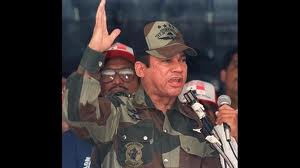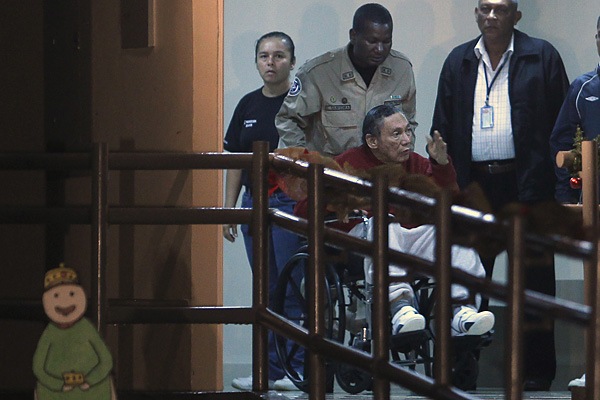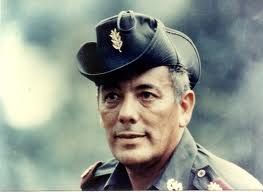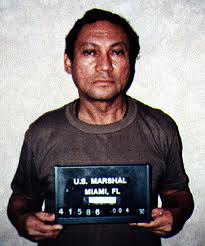At 7:36pm ON Sunday Dec 11, 2011 the former “strongman of Panama,” Manuel Antonio Noriega arrives to prison in Panama in the midst of a powerful security forces. He arrived earlier in the day from France and was first flown to a police station and then he was taken in a patrol car guarded by another police unit and two trucks. Noriega entered the prison in a wheelchair with the assistance of police.
Welcome home Manuel! Of course, while there was a lot of shouting ahead of his arrival and claims that hundreds of thousands of protesters would take to the streets only a couple of hundred showed up. What followed was a frenzy in the media for pictures, wall to wall coverage with opinions from every corner and of course Time magazine that takes its agenda for countries like Panama to the World. Before I get into the editorial, let me lay out the Noriega timeline with a few highlights of his career.
Please forgive me if I have not covered it all completely or if I have quoted some things in error as I am only the messenger on this one.

The former dictator Manuel Antonio Noriega returned to Panama today extradited from France, where since 2010 serving a sentence for money laundering, after more than twenty years in prison for drug trafficking in the United States.
This is a chronology of major events of his life:
1934 .- He was born on February 11.
1962 .- Enter the joint force military police and Panama.
1969 .- Named by intelligence chief General Omar Torrijos, head up the National Guard.
1981 .- Omar Torrijos dies in plane crash and was replaced as head of the National Guard by Colonel Florencio Flores.
1982 .- Colonel Rubén Darío Paredes assumes command of the National Guard to retire Colonel Flores. President Aristides Royo resignation citing health problems and replaces Vice President Ricardo de la Espriella.
1983 .- Walls were removed from the National Guard to run for president in 1984. Noriega assumed the military command, with the rank of General and change the name of the institution to Panama Defense Forces.
1984 .- The military candidate Nicolas Ardito Barletta won the presidential election three-time president Arnulfo Arias, amid allegations of fraud.
1985 .- kill guerrilla doctor Hugo Spadafora after accusing General Noriega of involvement in drug trafficking in Colombia.
1985 .- The President Ardito Barletta announced the creation of a commission to investigate the death of Spadafora, which bothers military leadership headed by Noriega, who forced him to resign.He replaces Eric Arturo Delvalle his vice president.
1987 .- Colonel Roberto Diaz Herrera, deputy commander of the Panama Defense Forces, denounced the corruption in the military and the Panamanian government after being forced to retire, opening up a crisis and leads protests from civilians.
1988 .- On February 4, a jury in Miami accused Noriega of drug trafficking and the United States imposed an economic blockade to Panama, freezing the bank accounts of this country and Noriega.
1988 .- On February 25 President Delvalle announced by radio and television to the country Noriega into retirement. The military denied and the Legislature, government majority, dismisses and appoints Del Valle Manuel Solis Palma as Minister for the Presidency.
1988 .- On March 16, at least 20 officers led by Col. Leonidas Macias attempting a coup against Noriega, who is suffocated by Urraca Battalion, commanded by Major Moises Giroldi.
1989 .- May 2 presidential elections were held despite a clear victory for the opposition Guillermo Endara, the Electoral Tribunal, under pressure from the military, canceled by alleged infiltration of foreign money in elections.
1989 .- On September 1, the Cabinet appointed comptroller general, Francisco Rodriguez, as provisional president.
1989 .- On 3 October, the biggest Giroldi, one of the officers closest to Noriega, he fails in an attempt to overthrow him. Those involved are executed.
1989 .- On 15 December the National Assembly Noriega gives the position of Head of Government, with almost unlimited powers in a time when he declared Panama in a state of war against the United States.
1989 .- On December 20 the Army of the United States invaded Panama to overthrow Noriega target and dismantle the Defence Forces.
1990 .- After spending a few days taking refuge in the Papal Nuncio, January 3 Noriega surrenders to U.S. troops and is brought to Florida guarded by drug agents.
1992 .- Noriega was tried in the U.S. and sentenced to 40 years in prison for drug trafficking (reduced later to 30 and finally 17 years of age thanks to his good behavior).
1993 .- The former dictator is convicted in absentia in Panama to 20 years in prison as the instigator of the murder of Hugo Spadafora.
1994 .- He is sentenced to 20 jail enpanamá as the instigator of the murder of more Giroldi in the abortive coup attempt.
1996: Sentenced to 15 years imprisonment and conspiracy to commit a crime in relation to the summary execution of nine officers involved in the attempt of Moses Giroldi.
1999 .- He was sentenced in absentia in France for 10 years in prison for money laundering linked to drug trafficking in that country.
2007 .- serve his sentence in Miami but remains in jail awaiting extradition is decided to France.
2008 .- France reiterates its request for extradition.
2010 .- Noriega arrives in Paris on April 27, extradited from the United States, where he spent 20 years in prison.
2011 .- Panama ratifies the extradition of Noriega applications to meet their sentences of 40 years in prison for the deaths of his opponents Hugo Spadafora and Moses Giroldi.
2011 .- May 24 The United States approved his extradition from France to Panama to serve their sentences.
2011: French Justice November 23 authorizes the extradition of Noriega to Panama.
2011: On December 11, arrived in Panama to serve their sentences for the murder of Spadafora and Giroldi and face other lawsuits over the death of union leader Heliodoro Portugal, as well as electoral fraud and violation of human rights.
So here we are and Noriega is back home to die in prison. What followed in the Time magazine article will certainly replace wiki leaks in the conversation circles here in Panama.
Panama has yet to escape its banana republic past
Panamanians are doing their best to register indifference to the return of Manuel Noriega. The 77-year-old former military dictator, drug-trafficking convict and all-around banana-republic creep, who’s been rotting behind bars in Florida and France since the 1989 U.S. invasion of Panama, was flown home Dec. 11 to begin serving 60 more years in prison for ordering the murders of political opponents in the 1980s. By collectively shrugging, his countrymen would like the rest of the world to think that Panama has moved well beyond those tropical strongman days, into a functioning, institutional democracy in which Noriegas are museum pieces.
Unfortunately, Panamanians are only fooling themselves, not us. While Panama can be commended for holding credible presidential elections since Noriega’s downfall, and its management of the Panama Canal since the 2000 U.S. handover has been stellar, the country has done little else to build its democratic bona fides.
Read more: http://globalspin.blogs.time.com/2011/12/13/noriegas-back-but-panama-has-yet-to-escape-its-banana-republic-past/#ixzz1gW70m665


